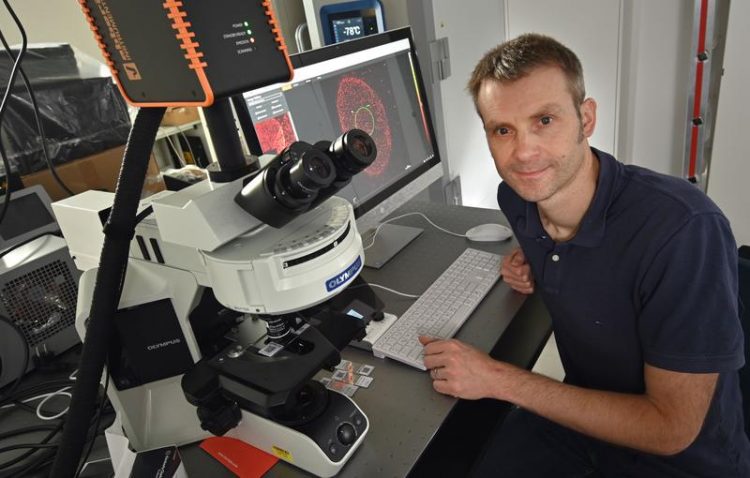Tracking the HI virus: Researchers makes visible, how AIDS pathogens multiply in the body

Christian Eggeling from Leibniz IPHT and the Friedrich Schiller University Jena Jan-Peter Kasper/ Friedrich Schiller University Jena
The researchers focused on the sluice through which the HI virus (Human Immunodeficiency Virus) emerges from the cell after having infected it: the plasma membrane of the host cell. They used the protein Gag as a marker, which coordinates the processes involved in the maturation of the virus.
“Where this protein accumulates, the decisive processes take place that lead to the virus releasing itself and infecting other cells,” explains Christian Eggeling. In order to decipher these, the researchers examined the diffusion at this budding site of the virus particle.
They found out that only certain lipids interact with the HI virus. Although these lipids were already known in principle, the research team was able to prove this interaction directly in living and infected cells for the first time.
Point of attack to prevent the virus from multiplying
“This provides us with a potential target for antiviral drugs,” says Christian Eggeling. “Knowing which molecules the HI virus needs in order to leave the cell and multiply is a crucial prerequisite for investigating how this can be prevented. With our technology, we can now follow this directly.“
Christian Eggeling and his team now want to develop antibodies that attack precisely these molecules — and thus suppress the spread of the virus.
“We not only want to study these antibodies from a medical point of view, but also to find out how their biophysical interaction can be used to enhance their efficacy,” says Eggeling, describing his research program.
“For this purpose, we analyze biological processes — namely the interaction of cells and molecules – with the aid of physical parameters such as diffusion. A good year ago, the physicist moved from Oxford to Jena. In addition to his professorship for “Superresolution Microscopy” at the university, he heads the research department “Biophysical Imaging” at Leibniz IPHT. He also leads his research group at the MRC Human Immunology Unit and at the Wolfson Imaging Centre of the Weatherall Institute of Molecular Medicine at Oxford University.
Christian Eggeling combines spatially superresolution fluorescence microscopy techniques with methods that enable the movement of labelled molecules to be tracked in real time in order to understand how diseases develop at the smallest molecular level. This enables him and his team of researchers to investigate individual molecules – for example in cell membranes – in living cells spatially and temporally. “This enables us to reveal cellular mechanisms at the molecular level that are far too fast for previous investigation methods and run on spatial scales that are far too small.
Christian Eggeling has already researched new superresolution fluorescence microscopy techniques at the Max Planck Institute for Biophysical Chemistry in Göttingen in the group of Stefan W. Hell. Together with Eric Betzig and William E. Moerner, Stefan Hell received the Nobel Prize for Chemistry in 2014. In Jena, Eggeling is now working closely with biologists and physicians to find out how these methods can be used to detect diseases earlier and more accurately and possibly even prevent them.
Prof. Christian Eggeling
Friedrich Schiller University Jena // Leibniz Institute of Photonic Technology
+49 3641 206-401 (Leibniz IPHT); +49 3641 9-47670 (University)
christian.eggeling(a)leibniz-ipht.de; christian.eggeling@uni-jena.de
C. Favard, J. Chojnacki, P. Merida, N. Yandrapalli, J. Mak, C. Eggeling, D. Muriaux: HIV-1 Gag specifically restricts PI(4,5)P2 and cholesterol mobility in living cells creating a nanodomain platform for virus assembly. In: Science Advances 2019, 5.
DOI: 10.1126/sciadv.aaw8651
https://www.leibniz-ipht.de/en/institute/presse/news/detail/dem-hi-virus-auf-der…
Media Contact
All latest news from the category: Life Sciences and Chemistry
Articles and reports from the Life Sciences and chemistry area deal with applied and basic research into modern biology, chemistry and human medicine.
Valuable information can be found on a range of life sciences fields including bacteriology, biochemistry, bionics, bioinformatics, biophysics, biotechnology, genetics, geobotany, human biology, marine biology, microbiology, molecular biology, cellular biology, zoology, bioinorganic chemistry, microchemistry and environmental chemistry.
Newest articles

Bringing bio-inspired robots to life
Nebraska researcher Eric Markvicka gets NSF CAREER Award to pursue manufacture of novel materials for soft robotics and stretchable electronics. Engineers are increasingly eager to develop robots that mimic the…

Bella moths use poison to attract mates
Scientists are closer to finding out how. Pyrrolizidine alkaloids are as bitter and toxic as they are hard to pronounce. They’re produced by several different types of plants and are…

AI tool creates ‘synthetic’ images of cells
…for enhanced microscopy analysis. Observing individual cells through microscopes can reveal a range of important cell biological phenomena that frequently play a role in human diseases, but the process of…





















